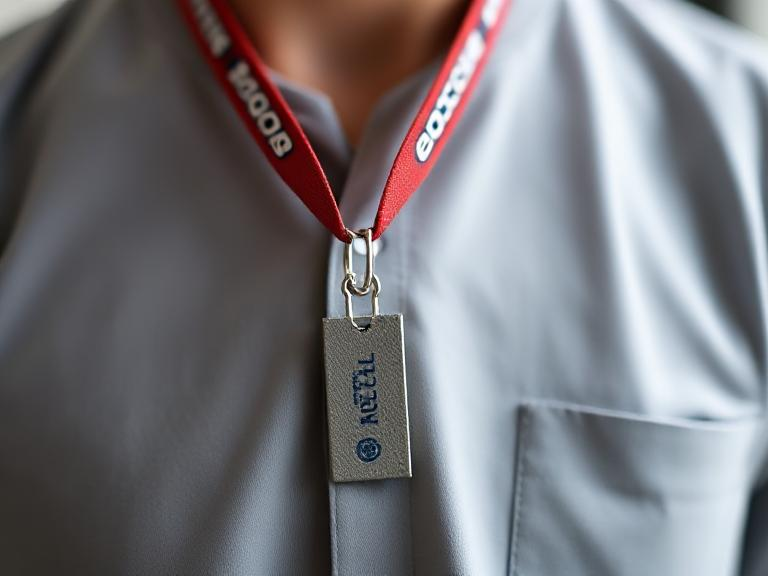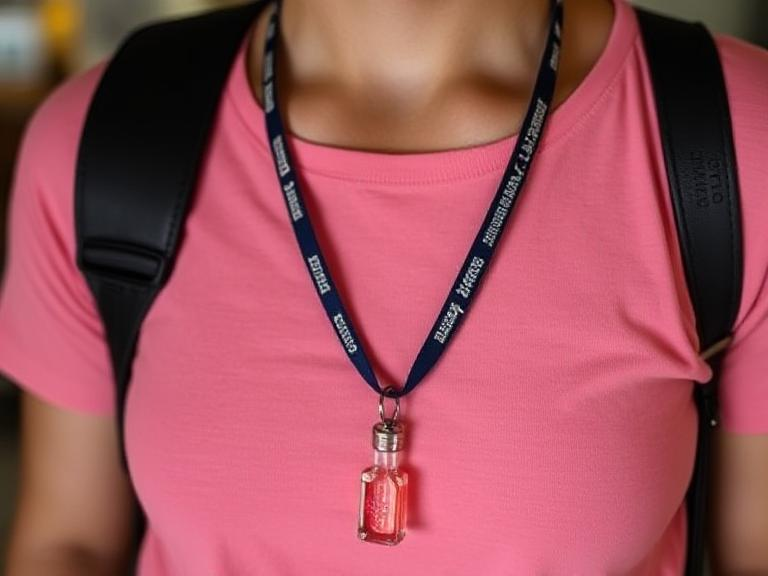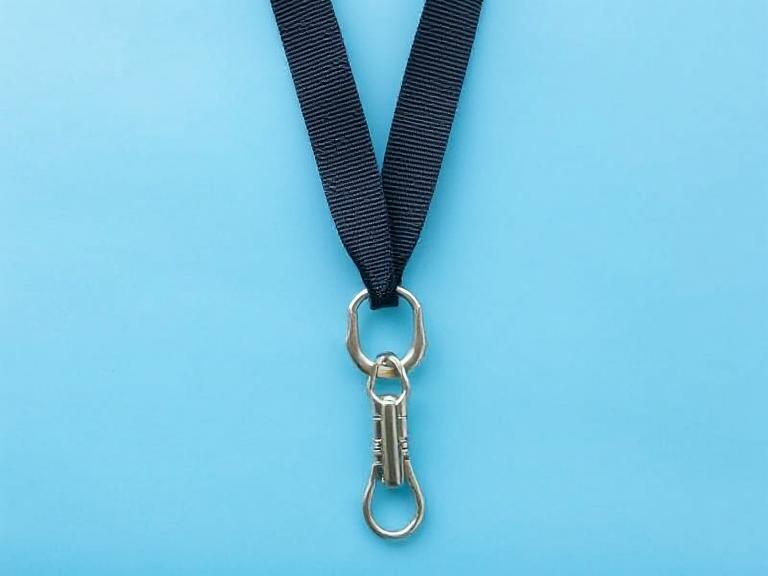Lanyards are ubiquitous in the business world, from annual conferences to everyday security uses.
Lanyards enable people to quickly identify the wearer and the brand behind them, sending a near-instant message and setting the tone for a meeting. If you want to put your brand’s best foot forward, you’ll need to understand the crucial role of lanyard materials.
Depending on the overall design of your lanyards, your brand could be positioned as the pinnacle of luxury–or as a haphazard, chaotic mess.
What material are lanyards made from? And what is the best lanyard material type for your needs?
There are many materials, from polyester to nylon, and additional customizations to consider. The best lanyard material will vary depending on your needs, but choosing durable and eye-catching substances is essential.
We’ll explore everything you need to know to create custom lanyards that wow your customers, employees, and vendors. Our team has been helping businesses craft customizable products for over a decade, working with major brands like Nike, Meta, and Google.
What are Lanyards?
Before we dive into lanyard material types and customization tips, let’s establish the basics.
Lanyards are looped material that can hang around your neck or attach to a badge holder. They feature branding text and logos and are often paired with identification.
This makes them a must-have for security at events and within your commercial facilities.
How Lanyard Materials Impact Function, Longevity, and Aesthetics
What material are lanyards made from? Can you just choose any old substance and forget about it?
Taking lanyard material types into consideration is a must. Lanyard materials directly affect the long-term durability and aesthetic appeal of your lanyards.
If you plan on distributing them for your conference or using them for identification, your choice has long-reaching consequences.
Durability and Strength
Promotional products have burned many business owners in the past. There are countless horror stories of products that break apart after just a couple of uses, all because of flimsy materials chosen to " save money.”
The best lanyard material types are sturdy enough to withstand wear and tear, maintain their strength even when attached to heavier objects like PVC badges, and won’t fray or rip easily.
What material are lanyards made from, and what is the best lanyard material for durability?
Polyester, Nylon, and other woven materials are generally your best bet. When creating one, go with a well-sourced company with a history of delivering quality products. There is a significant difference between premium polyester and cheap knockoffs.
Comfort and Wearability
When considering lanyard material types, you might think of the opposite end of the spectrum–why not choose a weighty and durable material like metal chains?
The reason is simple: Those materials are incredibly uncomfortable for most wearers, not to mention the extra costs involved.
Lanyard materials must hit that sweet spot of being something the wearer won’t notice much while simplifying identification and access.
Appearance and Branding
There’s another question you need to weigh–What is the best lanyard material for aesthetic appeal?
Look, being utilitarian can work wonders in many areas of your business.
But lanyards are practically walking billboards for your company. We’re talking about primetime advertising space for your brand or corporate sponsors.
As such, you don’t want your employees and vendors walking around looking like they’ve picked up something from the trash heap.
Look for lanyard materials that catch people’s attention, such as metallic accents, high thread counts, sublimated dyes, and shiny attachment clips.
Environmental Considerations
While many different types of lanyards exist, only a few meet a vital standard: eco-friendliness. Eco-consciousness and sustainability are an increasingly important factor for many consumers, and confidently stating your green business practices will pay off dividends.
What material are lanyards made from that also emphasizes sustainability? Look for recycled nylon, polyester, cotton, bamboo, and plastic.
What Material Are Lanyards Made From? The Best Lanyard Material Types

You now know that lanyard materials aren’t something to take lightly.
But what material are lanyards made from? And which ones should you choose for your business?
Let’s break them all down for you one by one.
Polyester Lanyards
Polyester is among the most common lanyard material types–and for good reason. It’s cost-effective, durable, and can be dyed to fit any brand design.
Investing in custom polyester lanyards is an excellent choice, and there are even customizations you can add, like metallic trims, to give them a luxurious feel. However, they aren’t usually the most durable type, so if you’re using your lanyards for the long run, Nylon may be a better choice.
There are biodegradable polyester lanyards, so you don’t have to sacrifice sustainability for style.
Nylon Lanyards
Luxury is the name of the game for nylon. This material combines a durably strength-to-weight ratio with a silky smooth sheen that catches the eye. That gives custom nylon lanyards a premium feel, making the wearers feel like VIPs.
As the light catches these nylon mini billboards, people will consider your brand a premium product.
Woven Lanyards
Weaving lanyards together offers a unique textured feel. Your lanyard designs are embedded in the material, meaning they won’t fade unless the material becomes unspooled.
The durability and texture help to engage more senses than a standard lanyard, increasing brand recognition. The reversible designs on custom woven lanyards add visual engagement to the experience.
Tubular Lanyards
Wearability is a vital factor when choosing lanyard materials. Tubular designs are lightweight, effectively eliminating neck strain. They also tend to have a larger surface area that stands out for bold branding.
Custom tubular lanyards still feature the color and logo options you need to conform to your brand identity.
Cotton Lanyards
Cotton is a newer material for lanyards. It is biodegradable and provides easy, lightweight wear.
However, cotton can fail to shine the way other materials do. It’s an excellent choice for matte, subdued styles if you’re okay with not having that premium aesthetic.
Bamboo Fiber Lanyards
Like cotton, bamboo lanyards are eco-friendly. They are soft to the touch and naturally antimicrobial.
But like cotton, bamboo doesn’t have the same aesthetic appeal. If you want a premium feel, your best bet is to find a lanyard made of a combination of bamboo fiber and another aesthetically engaging material, such as nylon or polyester.
PET (Recycled Plastic) Lanyards
PET is roughly as durable as traditional polyester. It uses recycled plastic for cost-effective sustainability. We prefer PET for ID cards and badge holders rather than the lanyards themselves.
This is because PET can be less durable and uncomfortable to wear, making it an awkward material for lanyards.
Satin Lanyards
Satin is a powerful luxury option with a smooth and sleek feeling. The lustrous finish is only matched by nylon blends.
However, satin tends to be more expensive than other materials, so you may be better suited to nylon or metallic-trimmed polyester.
So, What is the Best Lanyard Material?
There is no universal material that is best in all situations. However, we generally limit our choices to polyester and nylon, with a few cases where woven or tubular designs are strong.
Polyester is your all-around winner, with sustainability, cost-effectiveness, and many customization options.
Nylon has a more luxurious feel, enhanced durability, and a VIP aesthetic that promotes your brand.
Tubular designs are comfortable for wearers, making them a strong lanyard choice for identification. Woven lanyards are a solid option for event attendees, thanks to their unique texture, which engages multiple senses.
Ultimately, it’s best to consult a reliable retailer for specific concerns–the little details matter for your overall presentation.
Other Important Details in Designing Lanyards Beyond Materials

Lanyard materials are vital to the overall look and feel of your product. But it isn’t the only customization you need to consider before ordering.
Length and Width
The difference between a lanyard that becomes a loved souvenir and one that gets thrown away after the event can be a matter of inches.
The standard length for lanyards is 36 inches, which lets them land right around the lower torso. 32 inches is a nice choice for smaller individuals, while 42 inches works for taller folks. Some lanyards may include adjustability, which is essential to note when making a bulk order.
⅝ of an inch is your go-to for a subtle width. ¾ of an inch to 1 inch provides better aesthetic value for your brand design but can be slightly more uncomfortable to wear all day.
Attachment Options
Lanyards are meant to hold items–usually badges and ID cards. Choosing the proper attachment will ensure everything aligns aesthetically and functionally.
J-hooks are the classic choice, as they are easy to use and don’t break easily. Badge reels are extra strong and hold large ID cards, allowing quick scanning. C-clips, or “lobster claws,” are another great option with a premium feel.
Safety breakaways and carabiners should be considered when paired with specialized equipment like cameras.
Print and Customization
Ultimately, you can find the perfect material, but you're missing out if you haven’t identified the best things to put on a lanyard. Lanyards are like miniature billboards for your brand.
First, choose a color. Introductory color psychology can be an excellent guide, such as using green to represent growth or black to show luxury. Of course, you’ll want to ensure those colors match your overall brand identity.
Then, you’ll want to select a font that emphasizes your brand identity–either luxury or appealing to your company's trendy, quirky side. For readability, we recommend a minimum font size of 12pt.
From there, add additional features, like reflective strips, metallic trims, or unique textures. These help make your lanyard genuinely one-of-a-kind and increase the odds that people wear them long after your event has concluded.
Create the Perfect Personalized Lanyards at CustomLanyard.net!

Brand recognition can be challenging to achieve in today’s world. Audiences have shorter attention spans and will quickly latch on to the next shiny thing.
So why not make the shiny thing a customized lanyard? Businesses worldwide have used personalized lanyards to stand out at events, boost brand recognition, and beef up in-house security.
Those brands rely on one retailer above all others–our team here at CustomLanyard.net!
We’ve worked with brands like Microsoft and Yelp, creating aesthetically pleasing custom sublimation lanyards in various styles and materials.
Unlike many customized product brands that break apart after a few uses, our lanyards are built to last. We use premium polyester, nylon, and woven materials to help your logo stay vibrant for years rather than days.
Our lanyards' high material quality provides a comfortable wearing experience with silky smooth textures. That means your clients, vendors, and employees want to wear them, creating free advertising for your brand.
Our simple online design tool lets you quickly log on and select your options. You can select the dimensions, choose a material, choose various colors and textures, and customize your attachments.
But if you do want our guidance, we’re here to help. Our team provides top class customer support, whether walking you through the entire process step by step or giving our opinion on the best font for your message.
We even provide rush shipping and bulk pricing discounts to ensure a smooth experience for your company.
Wrapping Up Our Lanyard Material Guide
Choosing suitable materials for your lanyards can make or break your overall experience. While some materials will be the canvas for a positive branding experience that increases your reputation, others can do irreversible harm.
We recommend sticking with the classics, such as polyester, nylon, tubular, and woven designs, for the best results. However, if you work with the right brand, like CustomLanyard.net, you can still achieve eco-friendliness with these materials.
Our team has helped thousands of companies worldwide create custom products that people enjoy using. With our friendly staff, design team, and easy online tool, you can create jaw-dropping custom lanyards in minutes.
Hop on our website today to start brainstorming your next design, or contact our team with any questions!

/filters:quality(80)/fit-in/630x380/blog/image-1740445604.jpeg)